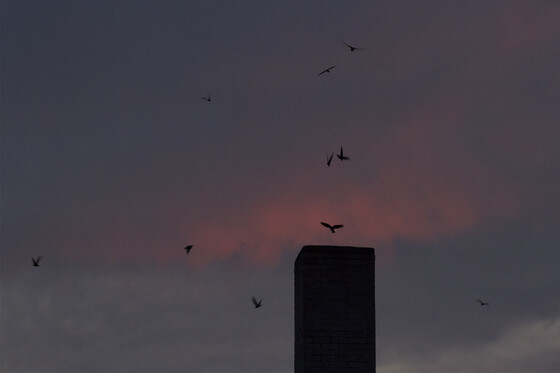DNR Asks Public To Help Count And Track Declining Chimney Swifts In Wisconsin
Chimney Swift Counts Help Identify Critical Roosting Sites For The Species

At dusk, large numbers of chimney swifts can be seen entering uncapped brick chimneys to roost in for the night. / Photo Credit: Wisconsin DNR
MADISON, Wis. – The Wisconsin Department of Natural Resources (DNR) asks the public to report chimney swift sightings to help monitor trends and locate important roost sites.
Swifts are small, unique birds that are in flight all day long as they hunt for flying insects. Their chittering sounds can be heard in Wisconsin starting mid-April into early May as they return from their winter homes in South America.
“Anyone can count chimney swifts as they enter chimneys in the early evening. It’s a simple process; no need to be a bird expert to do this. All someone needs to do is count,” said Karen Etter Hale, member of the Wisconsin Chimney Swift Working Group, a statewide volunteer effort to keep swifts common in Wisconsin.
According to the latest North American Breeding Bird Survey, the chimney swift population has declined by 72% in the past 50 years. By continuing to monitor these populations, the working group hopes to learn more about them and identify important roost sites so they can find ways to help protect them.
Here’s how you can help:
- Watch and listen for chimney swifts during the day while they hunt for insects. They may appear in the southern half of Wisconsin from late April to early May and soon after that in the northern half of the state.
- Look for tall brick chimneys that are uncapped. Should one find more than one chimney, do some scouting in the evenings to determine where the swifts will roost. Watch for swifts swooping over the chimney for a while before they enter. Be aware that the roost site choice can change from night to night, especially during migration.
- Pick one or more nights to monitor during this period.
- Observe the roost starting roughly 20 minutes before sunset until 10 minutes after the last swift enters the chimney. Stay in one location, even if there aren’t any swifts right away. They may come to that site later in a few moments. To be sure, stay 30 minutes after sunset to know if it was active or not. Even if an outing doesn’t yield any swift sightings in a chimney on a given night, please record this because it is still valuable information.
- Count (or estimate) the number of swifts as they enter the chimney. It’s useful to count in groups of five or 10 when they enter quickly in large numbers. A handheld clicker counter can be helpful.
- Residents can continue their count at large chimneys throughout the breeding season if many individuals continue to use these roost sites.
- Submit collected data to eBird.org. Please note that a free eBird.org account is required to log in and submit collected data. When prompted for a location, map the roost site to an exact address or point. After entering the number of chimney swifts, use the hashtag #SwiftWI in the chimney swift details section, making submitted data easier to access.
- Participants can add additional information in the chimney swift details section, in this exact order, with semicolons separating the data: #SwiftWI; the type of building (residence, school, church, business, hospital, apartment, swift tower/structure, etc.); the condition of the chimney (in good shape, in need of repair); any other notes. (Example: #swiftwi; residence; chimney in need of repair; any other notes.)
Visit the Wisconsin Chimney Swift Working Group website for more information on how to report sightings, and visit the Cornell Lab’s All About Birds Chimney Swift identification webpage to learn more about how to spot and listen for Chimney Swifts.
NOTE: This press release was submitted to Urban Milwaukee and was not written by an Urban Milwaukee writer. While it is believed to be reliable, Urban Milwaukee does not guarantee its accuracy or completeness.
Mentioned in This Press Release
Recent Press Releases by Wisconsin Department of Natural Resources
DNR Confirms CWD in Wild Deer in Clark County
Jan 5th, 2026 by Wisconsin Department of Natural ResourcesBaiting And Feeding Ban Extended
DNR Confirms CWD in Wild Deer in La Crosse County
Dec 22nd, 2025 by Wisconsin Department of Natural ResourcesBaiting And Feeding Ban Extended






















